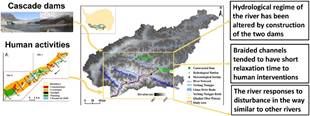
A
recent article entitled ‘Impacts of dams and land-use changes on
hydromorphology of braided channels in the Lhasa River of the Qinghai-Tibet
Plateau, China’, published in the International Journal of Sediment Research,
reported that the two cascaded dams only changed the flow regime of the
immediately downstream braided reach.
Abstract:
Among braided rivers developed on the Qinghai-Tibet Plateau of China at very
high elevations (>3,500 m), the middle and lower reaches of the Lhasa River
have been affected by comprehensive human activities mainly involving dam
construction, urbanization, farming, afforestation, and mining. In the current
study, the impacts of these human activities on hydrology and morphology of the
four braided reaches downstream of a cascaded of two dams are investigated. The
study period was divided into 1985–2006 (P1), 2006–2013 (P2), and 2013–2019
(P3), representing the natural and changed flow regimes by dams. Using
available daily discharge data at two stations within the four braided reaches,
dam-induced hydrological alteration was analyzed based on the indicators of
hydrologic alteration and range of variability approach and key discharge
proxies were calculated. Remotely sensed images also were selected in the three
periods and morphological metrics extracted from them were compared for the
four reaches among these periods. Attenuated hydrological regimes were found
for only two reaches. The total channel width (Wc) and braiding
intensity (BIt) followed different temporal trends among the four
reaches. Annual average shift rates of the main channel in the four reaches
were higher in the short (P2–P3) than in the long (P1–P2 and P1–P3) periods.
The longitudinal changes of Wc and the number of channels did not
have any identifiable trend among the four reaches. By linking the
morphological changes to quantified spatial and temporal patterns of various human
activities, it was found that (1) the two dams had insignificant impact on
channel morphology, suggesting that the studied braided river might have a
short relaxation time and (2) the evolutional trajectories of morphological
changes in most of the four reaches were similar, suggesting that temporal
trends of morphological changes due to complex human activities are not
affected by the different physiographic settings of the reaches. Continuous
exploitation of the valley area requires comprehensive river management
strategies for coordinating various human activities.
Highlights
l The two
cascaded dams only changed the flow regime of the immediately downstream
braided reach.
l Channel
morphology of the near-dam reach likely had a short relaxation time to recover
from less intense disturbances.
l Urbanization
and farming constrain the space available for the braided river to change.
l Historical
trajectories of channel adjustment in response to human activities are similar
among different braided reaches.
More
information: You, Y., Li, Z., Gao, P., Hu, T. (2022). Impacts of dams and
land-use changes on hydromorphology of braided channels in the Lhasa River of
the Qinghai-Tibet Plateau, China, International Journal of Sediment Research,
Vol. 37, No. 2, pp. 214-228.
https://doi.org/10.1016/j.ijsrc.2021.07.003
https://www.sciencedirect.com/science/article/abs/pii/S1001627921000445

